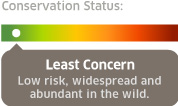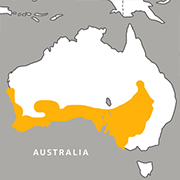Western grey kangaroo
Macropus fuliginosus melanops

About the Western grey kangaroo

Geographic Range:

Class: Mammalia
Order: Diprotodontia
Family: Macropodidae
Genus: Macropus
Species: fuliginosus
Subspecies: melanops
Kangaroos and wallabies are part of a group of mammals known as macropods, which means “large foot” in Latin. These bipedal (moving with two legs) marsupials are recognized by their long powerful hind legs and tail. Western grey kangaroos have light grey-brown to dark brown fur and large ears fringed with white hairs. Male kangaroos are typically larger than females, with more muscle mass in their forearms and chests. grey kangaroos are the most social macropods, and western and eastern grey kangaroos sometimes form mixed-species groups.
Western Grey Kangaroo Facts
Conservation: Humans, wildlife and environments are interdependent
Australia is a wealth of biodiversity, home to several species that are endemic, but also endangered. These habitats are an excellent example of how humans, wildlife and environments are interdependent. Wildlife is facing significant threats from human behaviors such as land modification, habitat destruction and inappropriate fire management. We can work together to implement creative and sustainable practices to protect biodiversity and habitat for future generations.
Fire plays a critical and role in Australian habitats. Many species have adapted to rely on regular exposure to fire. Indigenous Australian cultures have been responsibly using fire as a tool for tens of thousands of years, setting small fires to drive game for hunting, regenerate soil and vegetation, and clear land to find food and detect deadly snakes. The departure from these ancient practices, paired with rampant amounts of CO2 emissions from the burning of fossil fuels and human activities are leading to hotter and drier conditions and more frequent and severe wildfires, threatening biodiversity and human lives, not only in Australia but across the world.
Agencies in both Australia and the United States such as the U.S. Forest Service are working closely with Aboriginal leaders and North American Native tribes to incorporate traditional practices that promote land healing and biodiversity. We can model these partnerships by working together in our communities to reduce our use of fossil fuels for energy. Massachusetts offers a rebate and loan program called MassSave that can help save energy and money in your home.
Appearance:
Kangaroos and wallabies are part of a group of mammals known as macropods, which means “large foot” in Latin. These bipedal (moving with two legs) marsupials are recognized by their long powerful hind legs and tail. All macropods except for tree kangaroos move both hind legs at the same time and hop or jump to move about on land.
These kangaroos have light grey-brown to dark brown fur and large ears fringed with white hairs. Their muzzles are covered in fine hair, and the margins of their nostrils are bare black skin. Their paws, feet and the tips of their tail vary in color from brown to black. They have four toes on their hind feet; the two inside toes are jointed to form a grooming tool, and the extra-long middle toe has a sharp nail that can be used for protection.
Males have a strong, curry-like odor that’s distinct to this species. This odor has not been observed in other kangaroo species.
Size:
- Males
- Weight: 39 - 158 pounds
- Head-to-tail length: 37.2 - 87.6 inches
- Tail length: 16.7 - 39.4 inches
- Females
- Weight: 37 - 86 pounds
- Head-to-tail length: 26.4 - 68.7 inches
- Tail length: 17.4 - 32.1 inches
Male kangaroos are typically larger than females, with more muscle mass in their forearms and chests. A kangaroo’s size and age largely determine its dominance ranking. Large and medium males often dominate over females.
Diet:
Grey kangaroos prefer grasses, leaves and herbs, supplemented with small amounts of produce and grains. Males often feed for about an hour longer per day compared to females, presumably because males need to take in more energy to support their larger bodies.
Reproduction:
Kangaroos reach sexual maturity at 14 months of age. There is no particular breeding season; this species can breed at any time. Their gestation period is 31 days on average, ranging from 27 to 54 days. Joeys (baby kangaroos) weigh approximately 0.03 ounces at birth. Mothers can nurse two different joeys of different ages at the same time.
Behavior:
Grey kangaroos are the most social macropods, and western and eastern grey kangaroos sometimes create mixed-species groups. They form complex group hierarchies, with groups and subgroups making up their social structure. The average group size consists of three to six individuals, but can include up to 16 kangaroos. Larger groups tend to form around food, water and shade. Kangaroos will often move in and out of groups, with adult females and young forming the core of most groups. Group members have the benefit of sharing the duty of scanning for predators and spending more time feeding, though these activities may result in competition and resource depletion.
Often when a kangaroo joins a group, individuals will touch noses or bodies. Group members have been observed licking lips or parts of another individual’s body, and nuzzling females’ pouches. Group members may groom one another, though individuals also self-groom.
Associations among mature male kangaroos are loose and short-lived. In some populations, males have been observed seeking out the company of other males, resulting in male-female segregation, particularly in the non-breeding season. This may provide opportunities for males to size up their rivals or practice fighting. There are generally low levels of aggression among western grey kangaroos, except between males amid the breeding season.
During the breeding season, adult males travel through their home range, surveying and assessing the reproductive state of females. Males and females will sometimes use different habitats, separating into male-female groups within the habitat. Males have been observed to use grassland habitat, whereas females use lakebed, woodland and shrubland habitat.
A kangaroo’s daily activity is strongly influenced by changes in temperature and day length, as well as humidity and wind, which has a cooling effect. In hot weather, kangaroos rest in shallow “hip-holes” made in the shade.
These kangaroos are crepuscular, meaning they’re most active at dawn and dusk. The majority of a kangaroo’s non-resting time is spent feeding, particularly in winter. They forage 6-10 hours per day, often around dawn and dusk, and begin foraging later in the evening on hot days. In the summer, kangaroos spend about 20% less time foraging, possibly due to shorter nights and higher daytime temperatures.
Western grey kangaroos communicate through cough-like vocalizations, used to signal dominance and gain access to shade or food. They make a “ha” sound when pushing, particularly when a kangaroo attempts to displace an opponent. Females make a clicking sound when calling her joey to return to the pouch. Young kangaroos may give a short bleating or hissing call when they lose contact with their mother. Kangaroos will make loud thumps by jumping in the air and landing hard on the ground to communicate to potential predators or warn other kangaroos of a nearby predator. Kangaroos will rise up on their hind legs and tail to look for the source of disturbance.
Habitat/Range:
This species is endemic to southern Australia, from Shark Bay east to southwest Queensland. Their range includes west New South Wales and west Victoria, as well as South Australia’s Kangaroo Island. These kangaroos prefer areas with enough cover to provide shelter from weather and predators, and open, grassy areas where they can find food. They can be found in natural areas that experience rainfall or habitats near permanent water sources, including woodland, heathland, shrubland, forests and mallee scrub. These kangaroos can also live in human-modified habitats like pastures, croplands and even golf courses.
Threats:
Roadways and railways divide kangaroo habitat into smaller areas and kangaroos are forced to cross roadways to reach grazing areas, risking injury or death from motorists. Construction of large freeway underpasses allow western grey kangaroos to move between habitat fragments without the risk to kangaroo or motorist.
You Can Find This Animal in the Outback Trail
What's that smell?
Male western grey kangaroos have a strong, curry-like odor that’s distinct to this species. This odor hasn't been observed in other kangaroo species.
You might also like
At Franklin Park Zoo:
At Stone Zoo:

